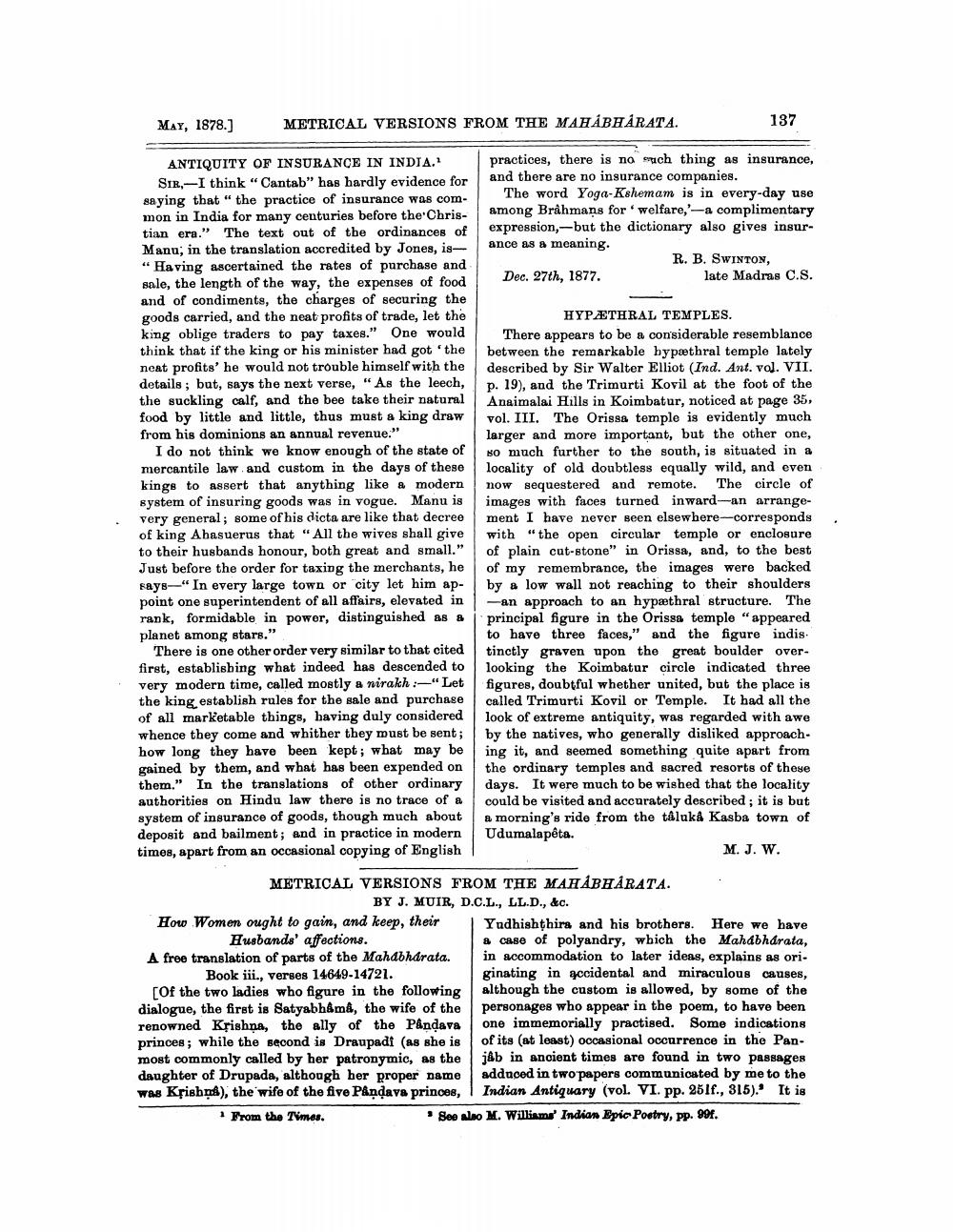________________
METRICAL VERSIONS FROM THE MAHABHARATA.
MAY, 1878.]
ANTIQUITY OF INSURANCE IN INDIA.1 SIR,-I think "Cantab" has hardly evidence for saying that" the practice of insurance was common in India for many centuries before the Christian era." The text out of the ordinances of Manu; in the translation accredited by Jones, is"Having ascertained the rates of purchase and sale, the length of the way, the expenses of food and of condiments, the charges of securing the goods carried, and the neat profits of trade, let the king oblige traders to pay taxes." One would think that if the king or his minister had got the neat profits' he would not trouble himself with the details; but, says the next verse, "As the leech, the suckling calf, and the bee take their natural food by little and little, thus must a king draw from his dominions an annual revenue."
I do not think we know enough of the state of mercantile law and custom in the days of these kings to assert that anything like a modern system of insuring goods was in vogue. Manu is very general; some of his dicta are like that decree of king Ahasuerus that "All the wives shall give to their husbands honour, both great and small." Just before the order for taxing the merchants, he says-" In every large town or city let him appoint one superintendent of all affairs, elevated in rank, formidable in power, distinguished as a planet among stars."
There is one other order very similar to that cited first, establishing what indeed has descended to very modern time, called mostly a nirakh :-"Let the king establish rules for the sale and purchase of all marketable things, having duly considered whence they come and whither they must be sent; how long they have been kept; what may be gained by them, and what has been expended on them." In the translations of other ordinary authorities on Hindu law there is no trace of a system of insurance of goods, though much about deposit and bailment; and in practice in modern times, apart from an occasional copying of English
How Women ought to gain, and keep, their Husbands' affections.
METRICAL VERSIONS FROM THE MAHABHARATA. BY J. MUIR, D.C.L., LL.D., &c.
137
practices, there is no such thing as insurance, and there are no insurance companies.
The word Yoga-Kshemam is in every-day use among Brahmans for welfare,'-a complimentary expression, but the dictionary also gives insurance as a meaning.
Dec. 27th, 1877.
A free translation of parts of the Mahabharata. Book iii., verses 14649-14721.
[Of the two ladies who figure in the following dialogue, the first is Satyabhama, the wife of the renowned Krishna, the ally of the Pânḍava princes; while the second is Draupadi (as she is most commonly called by her patronymic, as the daughter of Drupada, although her proper name was Krishna), the wife of the five Pândava princes,
1 From the Times.
R. B. SWINTON, late Madras C.S.
HYPETHRAL TEMPLES.
There appears to be a considerable resemblance between the remarkable hypæethral temple lately described by Sir Walter Elliot (Ind. Ant. vol. VII. p. 19), and the Trimurti Kovil at the foot of the Anaimalai Hills in Koimbatur, noticed at page 35, vol. III. The Orissa temple is evidently much larger and more important, but the other one, so much further to the south, is situated in a locality of old doubtless equally wild, and even now sequestered and remote. The circle of images with faces turned inward-an arrangement I have never seen elsewhere-corresponds with "the open circular temple or enclosure of plain cut-stone" in Orissa, and, to the best. of my remembrance, the images were backed by a low wall not reaching to their shoulders -an approach to an hypæethral structure. The principal figure in the Orissa temple "appeared to have three faces," and the figure indis. tinctly graven upon the great boulder overlooking the Koimbatur circle indicated three figures, doubtful whether united, but the place is called Trimurti Kovil or Temple. It had all the look of extreme antiquity, was regarded with awe by the natives, who generally disliked approach. ing it, and seemed something quite apart from the ordinary temples and sacred resorts of these days. It were much to be wished that the locality could be visited and accurately described; it is but a morning's ride from the tâluka Kasba town of Udumalapêta.
M. J. W.
Yudhishthira and his brothers. Here we have a case of polyandry, which the Mahábhárata, in accommodation to later ideas, explains as originating in accidental and miraculous causes, although the custom is allowed, by some of the personages who appear in the poem, to have been one immemorially practised. Some indications of its (at least) occasional occurrence in the Panjab in ancient times are found in two passages adduced in two papers communicated by me to the Indian Antiquary (vol. VI. pp. 251f., 315). It is See also M. Williams' Indian Epic Poetry, pp. 99f.




